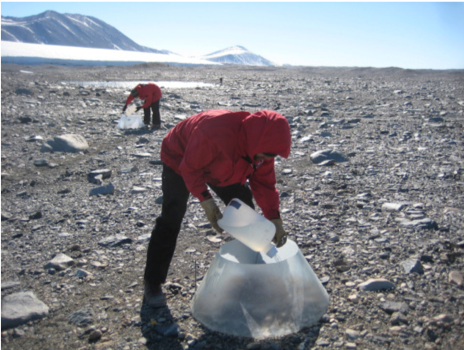
In 2007 we established a multiple nutrient addition experiment to examine how biotic responses to stoichiometric manipulations are constrained by landscape history and native geochemistry, e.g., soil N:P ratios (Fig. 1). Accordingly, we manipulated C, N and P availability in long-term experimental plots in soils with high levels of bulk P and soluble phosphate (low N:P) occurring on the Ross Sea Till (Fryxell basin) and on soils with low P availability and moderate to high concentrations of nitrate (high N:P) occurring on the Taylor III Till (Bonney basin). Measured response variables consist of in situ soil respiration, microbial biomass, population structure the invertebrate communities, and microbial community diversity and composition based upon 16S amplicon sequencing. We hypothesize that landscape history influences the response of soil communities to changes in resource availability because differences in native N and P availability have influenced soil biota over evolutionary and pedogenic timescales.
We found that the responses of soil biota to resource additions were influenced by the elemental stoichiometry of their local soils. For example, CN additions stimulated CO2 efflux and microbial biomass, and microbial diversity in low N:P soils; and CP, CN, and P additions stimulated CO2 efflux in high N:P soils. For the dominant soil animal, a free-living nematode Scottnema lindsayae, the year of sample collection and treatment type had significant effects on populations. In low N:P soils CN additions stimulated S. lindsayae relative to the unamended and water-amended plots; this effect of CN is largely associated with an increase in recruitment of juveniles. In contrast, in high N:P soils, CP, C and P additions stimulated S. lindsayae populations relative to unamended plots. CN treatments had a significant effect on the alpha and beta diversity of soil microbial communities at both sites, while CP treatments also influenced alpha and beta diversity in low-P soils occurring on the Taylor till. Phyla-level responses of soil microbial communities suggest that additions of CN and CP altered the composition of microbial communities from oligotrophic to more copiotrophic communities, with decreases in taxa belonging to the phylums Chloroflexi, Acidobacteria and Verrucomicrobia and increases in taxa from Actinobacteria and Proteobacteria phyla. Together, the observed changes in soil invertebrate and microbial communities and their functioning show that organisms are adapted to local soil conditions and demonstrate that native soil geochemical stoichiometry constrains the response of soil communities to changes in resource availability.
